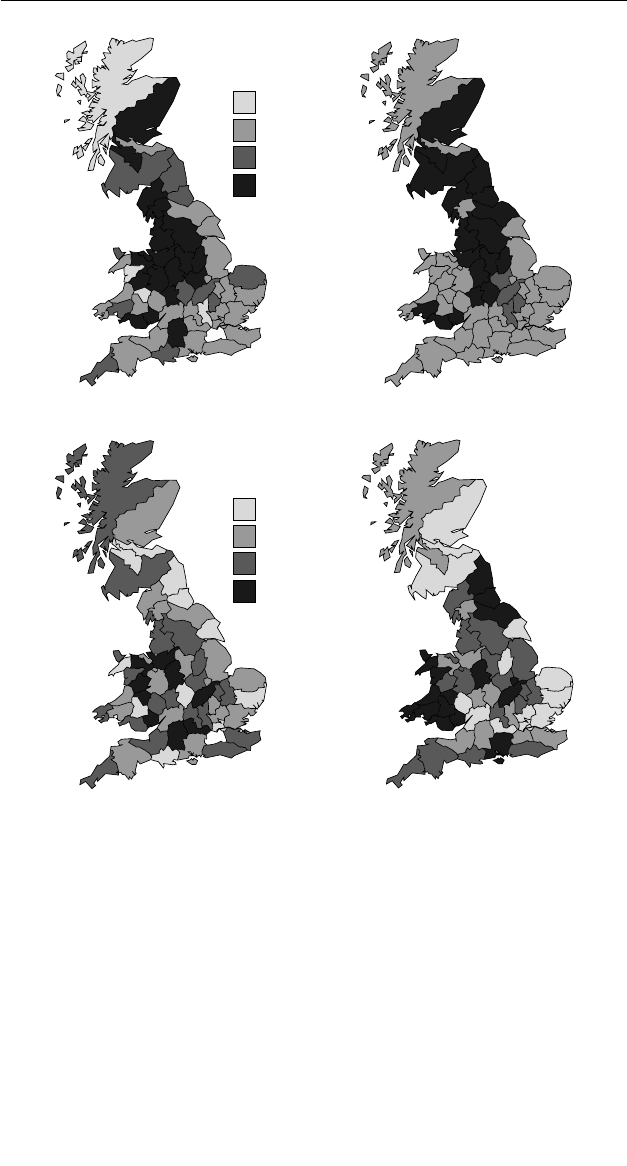Daunton M. The Cambridge Urban History of Britain, Volume 3: 1840-1950
Подождите немного. Документ загружается.


many other towns were dominated by textiles; for example, per cent of
Blackburn’s workers were in the sector. Such extreme concentrations of the
workforce into a single sector limited available services, and the lives of the
inhabitants. Unsurprisingly, dominant sectors were generally smaller by , so
only per cent of Blackburn’s workers, and per cent of Trowbridge’s, were
in textiles in ; only per cent of Stoke’s in pottery; only per cent of
Bath’s in domestic service; and so on.
David Gilbert and Humphrey Southall
Most diverse
Most specialised
Type of
specialisation
1841
1921
Agriculture
Staple industry
Light industry
Professional
*
Degree of
specialisation
*
Map . Urban occupational specialisations and , by type and by
degree
Source: and census occupational tables.
Cambridge Histories Online © Cambridge University Press, 2008

One consequence of such specialisation, especially when into one of the tra-
ditional staple industries, dependent on investment and overseas demand, was
vulnerability to cyclical fluctuation. As A. C. Pigou put it in : ‘A nation
which concentrates its forces upon the manufacture of the instruments of indus-
try courts thereby a relatively heavy burden of unemployment.’
98
He was com-
menting on Britain as a whole, but this was even more true of individual regions
and towns. Figure . plots national unemployment rates, variously measured,
from to the present.
99
The period covered saw such changes to the labour
market that simplistic comparisons of levels must be avoided, but four distinct
regimes of unemployment can be identified: from to , an almost
regular cycle of eight to ten years; sustained high unemployment in the interwar
The urban labour market
98
A. C. Pigou, Unemployment (London, ), p. .
99
The large problems of measurement and interpretation are discussed in H. R. Southall, ‘Working
with historical statistics on poverty and economic distress’, in D. F. L. Dorling and S. N. Simpson,
eds., Statistics in Society:The Arithmetic of Politics (London, ), pp. –.
0
5
10
15
20
25
1850 1860 1870 1880 1890 1900 1910 1920 1930 1940 1950 1960 1970 1980 1990 2000
Date
Percentage unemployed/paupers
Trade union %
Nat. insurance % (adults)
Nat. insurance % (all)
Poor Law (as % of total pop.)
Figure . Unemployment in the United Kingdom –
Sources: trade unions pre-: B. R. Mitchell, and P. Deane, Abstract of British
Historical Statistics (Cambridge, ), p. ; trade unions –:
Department of Employment and Productivity, British Labour Statistics: Historical
Abstract – (London, ), p. ; –: British Labour Statistics,
table (data exclude juveniles and persons insured under the agricultural
scheme); –: British Labour Statistics, table (data include juveniles and
persons insured under the agricultural scheme); –: British Labour
Statistics, table ; post- data taken from various issues of the British
Labour Statistics Yearbook, Social Trends and the Employment Gazette.
Cambridge Histories Online © Cambridge University Press, 2008

period; the post-Second World War boom; and higher unemployment again
since the s.
Many have asserted that pre- unemployment was concentrated in the
South.
100
Map .(a) shows long-run average unemployment among members
of the two largest artisan unions between and , these rates being dom-
inated by the impact of cyclical recessions. Rates were clearly higher in the
factory districts.
101
Although these data concern only artisan unionists, other evi-
dence such as the marriage rate suggests that major recessions had a drastic
impact on all parts of the labour market, through short-time and pay cuts as well
as lay-offs; for example, total numbers of marriages in Bolton doubled between
and as the economy recovered, while those where the groom was an
engineer trebled and even middle-class marriages increased by two-thirds. Much
of our knowledge of nineteenth-century towns comes from the census, but from
onwards it was always carried out during an upturn in the cycle. How
David Gilbert and Humphrey Southall
100
H. R. Southall, ‘The origins of the depressed areas: unemployment, growth and regional eco-
nomic structure in Britain before ’, Ec.HR, nd series, (), –
101
Computed using the January and July returns from all British branches of both unions, but engi-
neers, and carpenters and joiners were inherently urban.
Under 8.3
Over 16.0
11.5 to 16.0
8.3 to 11.5
(a) 1871-1910
(b) 1931
Under 2.1
Over 4.5
3.2 to 4.5
2.1 to 3.2
*
*
*
*
Average
% unemployed
% unemployed
Map . Urban unemployment rates – and
Sources: (a) Amalgamated Society of Engineers, Monthly Reports, and
Amalgamated Society of Carpenters and Joiners, Monthly Reports, January and
July only; (b) census reports, Occupational Tables, combining tables and
; Scottish data from census reports, vol. , Occupations and Industries,
table .
Cambridge Histories Online © Cambridge University Press, 2008

different a picture would we obtain from a recession year census? ‘Dovetailing’,
discussed above, would change the occupational structure; many artisan house-
hold heads would be on the road or even abroad, looking for work; many houses
stood empty, young couples moving in with relatives to save rent.
102
Map .(b) shows urban unemployment during the interwar Depression; the
use of census data enables us to cover all towns, and only towns, but the county
aggregates conceal many extremes: for example, per cent in Port Glasgow and
per cent in Jarrow, but only per cent in both Paisley and Durham City.
However, the regional divide was marked and consistent: only one tiny town in
the entire South-East outside London, Wivenhoe in Essex, had a rate over
per cent. A final contrast is with the census, where the national rate had
fallen from per cent to per cent, and the highest rates were mostly seaside
resorts, the census falling outside the holiday season.
By then, however, another division of labour between towns was influencing
prosperity: as discussed in the sections on factory and white-collar workers,
between centres of command and control, and hence white-collar jobs, and
older industrial towns, still reliant on manufacturing but now stripped of their
entrepreneurs and most of their managers. Map . shows middle-class occu-
pations, excluding clerical workers, and hence high earners. High rates in
The urban labour market
102
H. R. Southall and D. Gilbert, ‘A good time to wed? Marriage and economic distress in England
and Wales, –’, Ec.HR, nd series, (), –.
Over 23.0
Under 15.5
15.5 to 18.6
18.6 to 23.0
% in Classes
I and II
Map . Distribution of the urban middle class
Sources: data for England and Wales from census, County Reports
(London, ), table ; Scottish data from census reports, vol. ,
Occupations and Industries (Edinburgh, ), table .
Cambridge Histories Online © Cambridge University Press, 2008

Westmorland and rural Wales concern very small urban populations, and
without these a very clear North–South divide emerges. A more extreme divide
existed for ‘managers’, about per cent of the workforce in the Home
Counties and per cent in communities such as Purley and Esher, but about
. per cent in Durham and Monmouthshire, and little over per cent in some
mining towns.
103
This was the legacy of industrialisation in much of urban
Britain at the end of our period: communities with full employment but depen-
dent on a narrow economic base and often on one or two large employers con-
trolled from outside; and as a result of that base and pattern of control, having a
narrow social base as well.
David Gilbert and Humphrey Southall
103
Computed from tables and in Census England and Wales: Occupational Tables (London,
; transcription supplied by Daniel Dorling) and table in Census Scotland, vol. :
Occupations and Industries (Edinburgh, ).
Cambridge Histories Online © Cambridge University Press, 2008

·
·
Urban fertility and mortality patterns
(i)
D
decades of the s and s, urban – and with it
national – mortality, fertility and nuptiality patterns all appear to have
almost simultaneously begun to enter a new era.
1
For the first time large
industrial cities were proving themselves capable of combining high rates of
expansion with improving (albeit very gradually before the twentieth century)
mortality conditions for the majority of the urban working population.
Secondly, marital fertility was apparently coming under tight control. Whereas
previously fertility had been regulated in British society primarily through a set
of institutional arrangements governing young adults’ expectations of the appro-
priate economic circumstances under which marriage could be undertaken,
now there were increasingly systematic attempts to control the chances of con-
ception after marriage, as well.
2
There was also an increase in the rate of over-
seas migration (mainly from Britain’s cities) during this period, the other
principal component in the demographic equation, though this was never as
influential a factor as in Ireland’s demographic history.
3
Thus, the demographic
1
For accessible introductions, see N. Tranter, Population and Society –: Contrasts in Population
Growth (London, ); and M. Anderson, ed., British Population History (Cambridge, ).
2
E. A. Wrigley and R. S. Schofield, Population History of England (London, ), chs. –.Fora
recent review of developments in this field and interesting additional insights into the nature of insti-
tutional controls on marriage in early modern Britain, see S. Hindle, ‘The problem of pauper mar-
riage in seventeenth-century England’, Transactions Royal Historical Society, th series, (), –.
3
The emigration rate was running at about . persons per thousand over the two decades before
and rose to about . per thousand over the next four decades (during which period there
was also a somewhat off-setting inflow from Eastern Europe), thereafter falling back to about .
per thousand in the s. These rates of emigration were dwarfed by Ireland’s, which were as
high as per thousand in the s, s and s. Scottish emigration rates ran at about per
thousand throughout the second half of the nineteenth century, but then increased to approxi-
mately per thousand during the period –, when they exceeded Irish rates. D. E. Baines,
Emigration from Europe – (London, ), Table ; and see also D. E. Baines, Migration in
a Mature Economy (Cambridge, ).
Cambridge Histories Online © Cambridge University Press, 2008

history of urban Britain during the period – is particularly dominated
by the dramatic changes in mortality and fertility occurring during the central
decades of that period, c. –, which will therefore constitute the primary
focus of attention in this chapter.
These developments had many long-term implications for the social charac-
ter and needs of Britain’s cities. In the earlier nineteenth-century decades the
proliferation of hordes of infants, children, youths and young men and women
on the unpaved and unlit streets of the smoky, industrial ‘frontier’ towns was
undoubtedly something which endowed them with a novel and threatening
character, compared with the more familiar complexion of life in the older and
slower-growing southern county, market and cathedral towns, including even
London. The full cultural and political sociological implications of this novel age
structure still remain to be explored by historians. But it can be safely asserted
that the relentless youthfulness was caused by the combination of the new cities’
expansion through substantial in-migration of young adults, the relatively high
fertility of their inhabitants and the fact that they were expanding so fast in pro-
portionate terms each decade (so that the relatively small cohorts of oldest resi-
dents were proportionately swamped by the much larger and ever-expanding
successive cohorts of younger newcomers). The subsequent fall in fertility
(initially partially offset by the dramatic improvements in infant survivorship
achieved –) and the attenuated flow of migration from the de-populated
countryside combined to produce a marked slow-down in the rate of growth of
most cities from the beginning of the twentieth century. These were the prin-
cipal demographic forces resulting in the twentieth-century ‘ageing’ of Britain’s
great industrial centres, whereby the world’s new, vigorous shock cities of the
mid-nineteenth century have matured to become the country’s familiar ‘senior
citizens’ in an architectural, residential and sociological sense, reflecting the rel-
ative ‘greying’of their residents through an evening up of the balance of middle-
aged and senior citizens relative to the young.
Historians and social scientists have long been attracted to the idea that these
important demographic movements – the apparently almost simultaneous
downturn in the mortality and fertility indices – must in some way be causally
related to each other. This is the suspicion lying behind the long-influential
notion that a ‘demographic transition’ necessarily results from the kind of sus-
tained economic growth involved in industrialisation and the concomitant rise
of a ‘modern’ urban society.
4
However, attempts to verify empirically a direct
relationship between mortality and fertility change in this period in Britain,
Simon Szreter and Anne Hardy
4
For the most influential formulation of the theory of demographic transition, see F. W. Notestein,
‘Population – the long view’, in T. W. Schultz, ed., Food for the World (Chicago, ), pp. –;
and for a critical history of the idea, see S. Szreter, ‘The idea of demographic transition and the
study of fertility change: a critical intellectual history’, Population and Development Review,
(), –.
Cambridge Histories Online © Cambridge University Press, 2008

including careful efforts to distinguish infant from child and other forms of
mortality, have only resulted in negative or contradictory statistical findings.
5
In
this chapter, therefore, separate treatments of the history of changing urban
mortality and fertility have been offered, reflecting the two distinct bodies of
historiography.
(ii)
Two principal features dominate urban mortality patterns in the period to
: initially high death rates (extremely high in many industrial towns), which
began to decline from about ; and a gradual shift in the main causes of death
from infectious to chronic and degenerative diseases.
6
The high death rate/high
infectious disease rate regime, especially marked in the second and third quar-
ters of the nineteenth century, was the result of unregulated industrial and urban
growth, which reduced many residential areas in towns and cities across Britain
to squalid, stinking dormitories. Whereas eighteenth-century citizens had often
made successful efforts to clean up their towns and stave off the ravages of infec-
tious disease, such efforts seem to have been insufficiently maintained during the
first half of the nineteenth century.
7
By , urban Britain was highly insani-
tary, as Edwin Chadwick’s great Sanitary Report of graphically docu-
mented and as the ensuing Health of Towns Commission confirmed.
8
These urban environments formed a perfect breeding ground for endemic
infectious diseases, as well as for that terrifying visitor, cholera. Badly ventilated
and overcrowded houses, where families too often lived each to a room, with
as many families in the house as there were rooms, encouraged the spread of
diseases transmitted by droplet infection and close contact: whooping cough,
measles, scarlet fever, smallpox and tuberculosis. Thousands of children died
Urban fertility and mortality patterns
5
M. Kabir, ‘Multivariate study of reduction in child mortality in England and Wales as a factor
influencing the fall in fertility’ (PhD thesis, University of London, ); R. Woods, P. A.
Watterson and J. H. Woodward, ‘The causes of rapid infant mortality decline in England and
Wales, –’, Population Studies, Part , (), –, part , (), –.
6
For important recent historical epidemiological studies, see A. Mercer, Disease, Mortality and
Population (Leicester, ); R. Woods and N. Shelton, An Atlas of Victorian Mortality (Liverpool,
); J. Vogele, Urban Mortality Change in England and Germany, – (Liverpool, ); A.
Cliff, P. Haggett and M. Smallman-Raynor, Deciphering Global Epidemics.Analytical Approaches to the
Disease Records of World Cities, – (Cambridge, ); R. Woods, The Demography of
Victorian England and Wales (Cambridge, ).
7
For eighteenth-century reforms and renovations see C. W. Chalklin,The Provincial Towns of Georgian
England (London, ); P. J. Corfield, The Impact of English Towns – (Oxford, ), ch.
; James Riley, The Eighteenth-Century Campaign to Avoid Disease (London and Basingstoke, );
P. Borsay, The English Urban Renaissance: Culture and Society in the Provincial Town, –
(Oxford, ); Roy Porter, ‘Cleaning up the Great Wen’, in W. F. Bynum and R. S. Porter, eds.,
Living and Dying in London, Medical History (Supplement, ).
8
M. W. Flinn, ed., Report on the Sanitary Condition of the Labouring Classes of Great Britain (Edinburgh,
).
Cambridge Histories Online © Cambridge University Press, 2008

every year from secondary respiratory infections following on measles and
whooping cough, because these diseases were considered as a child’s rite of
passage, and sufferers not put to bed and nursed, but allowed to run the streets
as usual.
9
Outbreaks of typhus, which is spread in the faeces of the human body
louse, characterised times of economic depression, when families tried to econ-
omise on rent by doubling up in already inadequate accommodation.
10
Toilet
facilities were too often neglected and frequently completely insufficient for the
number of people using them, resulting in endemic gastro-intestinal infections,
of which typhoid and diarrhoea were the most fatal. Typhoid, indeed,
flourished as urban water supplies deteriorated in quality – as raw sewage
entered rivers and streams from which domestic water supplies were drawn in
ever increasing quantities, and as pressures on urban land led to wells and cess
pits being sunk too close together, so that leakage and soakage from one to the
other was commonplace.
11
Festering deposits of domestic refuse and stable
manure – the latter a massive problem in a horse-drawn society – constituted
regular health hazards which local government struggled to contain into the
early twentieth century. In particular, they formed splendid breeding grounds
for flies which swarmed in their millions in Victorian cities in the summer
months, and were heavily implicated as the vehicle of transmission for infant
diarrhoea, which killed thousands of babies between July and October every
year.
12
As a group, the infectious diseases were responsible for some per cent of all
urban deaths around ,butby their mortality had fallen to less than
per cent. Typhus and smallpox had virtually vanished from the mortality tables;
typhoid and tuberculosis were greatly reduced and still falling; scarlet fever had
markedly reduced in virulence. Deaths from whooping cough had begun to
decline, and even measles, diphtheria and diarrhoea were showing signs of
diminishing fatality. While some of these decreased fatalities can be explained by
improved water supplies (typhoid, cholera), or rising standards of personal
hygiene and housing (typhus), or autonomous decreases in virulence (scarlet
fever), the overall reduction in deaths from this group of diseases has been the
Simon Szreter and Anne Hardy
19
A. Hardy, The Epidemic Streets (Oxford, ), chs. , ; A. Hardy, Health and Medicine in Britain
since (Basingstoke, forthcoming).
10
See A. Hardy, ‘Urban famine or urban crisis? Typhus in the Victorian city’, in R. J. Morris and
R. Rodger, eds., The Victorian City (London, ).
11
A. Hardy, ‘Parish pump to private pipes: London’s water supply in the nineteenth century’, in
Bynum and Porter, eds., Living and Dying.
12
For the most convincing demonstration of the significance of flies in producing infant diarrhoea,
see the outstanding article by Ian Buchanan: ‘Infant feeding, sanitation and diarrhoea in colliery
communities, –’, in D. J. Oddy and D. Miller, eds., Diet and Health in Modern Britain
(London, ), –. See also Nigel Morgan, ‘Infant mortality, flies and horses in later nine-
teenth century or early twentieth century towns: a case study of Preston’, Continuity and Change
(forthcoming).
Cambridge Histories Online © Cambridge University Press, 2008

subject of a major historical debate, centring on Thomas McKeown’s contention
that improved nutrition leading to enhanced resistance was primarily responsible
for their decline. McKeown acknowledged only a secondary contribution for
public health measures, but others have given much greater weight to social
intervention.
13
In his concern to de-mythologise the achievements of medical science,
McKeown placed primary emphasis on the importance of economic growth as
his preferred alternative explanation for rising standards of health in the popu-
lation. Primarily, he envisaged this occurring through increased real wages facil-
itating improved per capita nutritional intake. However, it has recently been
argued that a diametrically opposite interpretation of the relationship between
economic growth, urbanisation and health seems more consistent with the evi-
dence of Britain’s economic and demographic history.
14
When the health of the
industrial urban workforce is measured either through life tables or by the record
of children’s height attainments, there are unequivocal signs of serious deteri-
oration during precisely the period of most pronounced per capita economic
growth and rising real wages: the second and third quarters of the nineteenth
century. This deterioration was not truly repaired until the last quarter of the
century, or even later where infants are concerned.
15
The sanitation, hygiene, crowding and poverty diseases were undoubtedly
both the chief killers and the principal causes of feeble growth among the sur-
vivors: generations of children whose metabolisms were chronically starved of
Urban fertility and mortality patterns
13
The principal statement by Thomas McKeown was The Modern Rise of Population (London, ).
The opposing case was made in S. Szreter, ‘The importance of social intervention in Britain’s
mortality decline, c. –: a reinterpretation of the role of public health’, Social History of
Medicine, (), –; and the ensuing debate: S. Guha, ‘The importance of social interven-
tion in England’s mortality decline: the evidence reviewed’, Social History of Medicine, (),
–; S. Szreter ‘Mortality in England in the eighteenth and nineteenth centuries: a reply to
Sumit Guha’, Social History of Medicine, (), –. Important historical studies document-
ing the nature of public health work and preventive medicine in Britain’s nineteenth-century
cities have included R. Lambert, Sir John Simon – and English Social Administration
(London, ); F. B. Smith, The People’s Health, ‒ (London, ); A. S. Wohl,
Endangered Lives (London, ); Hardy, Epidemic Streets; J. M. Eyler, Sir Arthur Newsholme and
State Medicine, – (Cambridge, ).
14
S. Szreter, ‘Economic growth, disruption, deprivation, disease and death: on the importance of
the politics of public health for development’, Population and Development Review, (),
–.
15
S. Szreter and G. Mooney, ‘Urbanisation, mortality and the standard of living debate: new esti-
mates of the expectation of life at birth in nineteenth-century British cities’, Ec.HR, nd series,
(), –; for evidence on heights, see R. Floud, K. Wachter and A. Gregory, Height,
Health and History (Cambridge, ). Note that the most recent research indicates more modest
gains in national average real wages during the second quarter of the nineteenth century than pre-
viously suggested (though whatever gains there were would have been proportionately greatest
among urban industrial, rather than rural workers): C. Feinstein, ‘Pessimism perpetuated: real
wages and the standard of living in Britain during and after the Industrial Revolution’ Journal of
Economic History, (), –.
Cambridge Histories Online © Cambridge University Press, 2008
